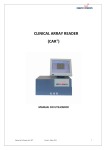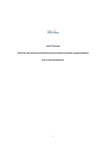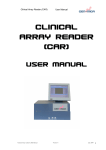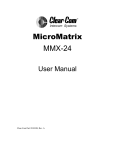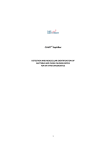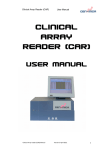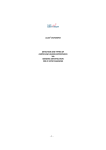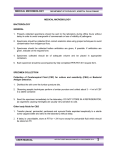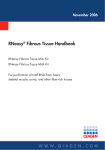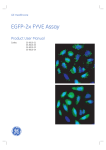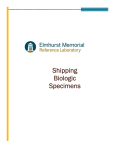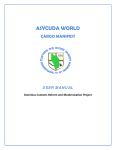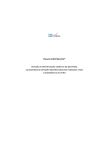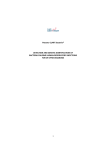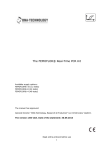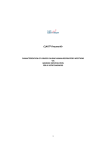Download User manual CAR
Transcript
CLINICAL ARRAY READER (CAR®) USER MANUAL User manual Version 8 July 2015 1 CAR® (CLINICAL ARRAY READER) CAR, CLART, CLART-Strip, SAICLART, ENTHERPEX, ENTEROBAC, PNEUMOVIR, PNEUMO CLART BACTERIA and SEPTIBAC are registered Trademarks of GENOMICA. For more information, please refer to the web site www.genomica.com GENOMICA, S.A.U. Parque Empresarial Alvento, Edificio B Calle Vía de los Poblados, 1 – 1ª planta 28033 Madrid, Spain www.genomica.com Version 8 July 2015 User manual Version 8 July 2015 2 1. TABLE OF CONTENTS 1. TABLE OF CONTENTS ................................................................................................... 3 2. PRINCIPLE OF OPERATION OF THE DEVICE ...................................................................... 5 3. INTENDED USED .......................................................................................................... 8 4. USE: ......................................................................................................................... 10 5. CLASSIFICATION ........................................................................................................ 10 6. TRADING NAME OF THE PRODUCT AND REFERENCES .................................................... 11 7. COMPONENTS ........................................................................................................... 11 9. SPECIFICATIONS. ........................................................................................................ 13 10. UNPACKING, STORAGE AND PACKING. ....................................................................... 15 11. ENVIRONMENTAL CONDITIONS ................................................................................. 17 12. USAGE PRECAUTIONS ............................................................................................... 18 13. MAINTENANCE ........................................................................................................ 20 14. CLEANING ............................................................................................................... 20 15. CARING FOR THE DEVICE AFTER USE .......................................................................... 21 16. PREPARATION OF THE PLACE BEFORE INSTALLATION ................................................... 22 17. INSTALATION ........................................................................................................... 23 1. UNLOCK/ LOCK OF THE READER ........................................................................... 23 2. ASSEMBLING THE SCREEN ................................................................................... 24 18. SWITCHING THE CAR® ON/OFF .................................................................................. 27 1. SWITCHING ON.................................................................................................. 27 2. SWITCHING OFF ................................................................................................. 27 19. READING PROCESS (CLART® Strips) ........................................................................... 28 1. SETTING NUMBER OF SAMPLES TO BE ANALYZED .................................................. 30 2. SETTING ASSAYS IDS ........................................................................................... 33 3. SETTING SAMPLE’S IDS ....................................................................................... 35 4. WORKING LIST ................................................................................................... 37 User manual Version 8 July 2015 3 5. READING PROCESS ............................................................................................. 38 6. RUN REPORT ..................................................................................................... 40 7. RESULTS............................................................................................................ 41 8. REANALYZING SAMPLES...................................................................................... 42 20. MAIN MENU ............................................................................................................ 45 1. HISTORY............................................................................................................ 45 2. CONFIGURATION ............................................................................................... 46 21. FREQUENTLY ASKED QUESTIONS (FAQ) ...................................................................... 51 1. SOFTWARE UPDATING AND INSTALLATION ........................................................... 51 2. EXPORT RESULTS-EXPORT ROUTE ........................................................................ 52 3. BARCODE READER: CHARACTERISTICS AND INSTALLATION. .................................... 53 4. DEFAULT TEST CHANGE ...................................................................................... 53 ANNEX A. TABLE OF FREQUENT ERRORS AND THEIR SOLUTION .......................................... 54 ANEXO B. DECLARATION OF CONFORMITY ....................................................................... 55 ANEXO D. USED SYMBOLS .............................................................................................. 56 User manual Version 8 July 2015 4 2. PRINCIPLE OF OPERATION OF THE DEVICE The CLINICAL ARRAY READER (CAR®) has been designed for a quick detection and analysis of CLART-Strip®. The overall process of analyzing a sample involves several steps: • ADN extraction • DNA amplification and target labelling • Specific hybridisation and visualization of the results. • Reading and interpretation of the results The CLINICAL ARRAY READER (CAR®) has been designed for the reading and interpretation phase of the In vitro medical devices manufactured by GENOMICA. Amplification and visualization phase on CLART® is based on the precipitation of an insoluble product at those sites of the microarray where the hybridization of the amplified products by specific probes takes place. This insoluble product shows a patron of spots on the array that will be interpreted by the reader CAR® (CLINICAL ARRAY READER). The technique is based on an image capturing system and a data processing unit from the microarray, that generates a unique automatic report from each sample. The algorism of every kit has been validated during the performance evaluation of the kit. The result obtained by the CAR® are shown in a touch screen and they can be printed or exported to a your LIMS or USB unit The image capturing arrangement includes a LED that provides visible light towards the array, a diffusor that homogenizes the stream of light before it reaches the array, and a CCD camera, that captures the image. User manual Version 8 July 2015 5 In order to the correct colocation of the tube or plate, the device is provided with an automatic positioning system for the microarray. The imagine processing is carried out in two formats (tubes and micro plates) by a specific software developed by GENOMICA. The image analysis is completely automated avoiding the subjectivity in the interpretation of the results by the user. Therefore the result will be more accurate in a rapid and repeatable way. Furthermore its design allows any kind of user an easy personalization. In comparison to other systems of micro-arrays, this one simplifies the hybridation and visualization process highly. This enables to survey biological samples for hundreds of diseaseassociated biomarkers simultaneously, and obtain the needed controls to guarantee the reliability of the results. User manual Version 8 July 2015 6 Experimental Procedures Visualization Sample preparation, DNA extraction and DNA amplification/labelling of targeted molecules Standard laboratory equipment Specific hybridisation: labelled sample incubation against AS-chip. Visualization: conjugation and precipitation of the staining. Colorimetric Detection and Analysis. CAR® (CLINICAL ARRAY READER) User manual Version 8 July 2015 7 3. INTENDED USED The CLINICAL ARRAY READER (CAR®) will exclusively be used by qualified laboratory staff in the following Tests For any non-listed used, GENOMICA does not ensure the correct functioning of the equipment. CLART® KIT NAME OBJETIVE TARGETS FOR DIAGNOSIS CLART® HPV2 Detection and typing of human papillomavirus 2 Human Papillomavirus 2 Kit detects up to 35 (6, 11, 16, 18, 26, 31, 33, 35, 39, 40, 42, 43, 44, 45, 51, 52, 53, 54, 56, 58, 59, 61, 62, 66, 68, 70, 71, 72, 73, 81, 82, 83, 84, 85 and 89) CLART® ENTHERPEX Detection and typing of Herpes and Enterovirus. CLART® EnteroBac® Detection and identification of genetic Enterobacteriaceae causing diarrhea. KIT COMPONENTS • • • • Extracción Reagents Amplification Reagents Visualization Reagents Specific assay software HSV-1,HSV-2, VZV, CMV, EBV, HHV-6, HHV-7,HHV-8, Poliovirus, Echovirus y Coxsackievirus spp. • • • • Extraction Reagents Amplification Reagents Visualization Reagents Specific assay software Salmonella spp. (all the described species in the manual), Shigella spp. (S. dysenteriae, S. Sonnei, S. boydii and S. flexneri),Yersinia enterocolitica, Yersinia spp. (Y. pestis, Y. pseudotuberculosis, Y. enterocolítica),Campylobacter spp. (C. lari, C. laridis, C. upsaliensis, C. jejuni, C. coli) Campylobacter jejuni, Campylobacter coli, Escherichia coli enteropathogenic EPEC: (E. coli enterohemoragic, E. coli enteroinvasive, E. coli enterotoxigenic and E. coli enteropathogenic), Clostridium difficile B, and Aeromonas spp, producers of aerolisin . • • • Amplification Reagents Visualization Reagents Specific assay software CLART® PneumoVir® Characterization of virus causing human respiratory viral infections Adenovirus; Bocavirus; Coronavirus; Enterovirus (Echovirus); Influenza virus A (subtypes H3N2 human, H1N1 human, B, C and H1N1/2009); Metapneumovirus (subtypes A and B); Parainfluenza virus 1, 2, 3, and 4 (subtypes A y B); Rhinovirus; Respiratory Syncitial Virus type A (VSR-A); Respiratory Syncitial Virus type B (VSR-B). • • • • Extraction Reagents Amplification Reagents Visualization Reagents Specific assay software Pneumo CLART bacteria® Characterization of virus causing human respiratory bacterial infections. Staphylococcus aureus, Streptococcus pneumonia, Haemophilus influenza, Haemophilus spp, Moraxella catarrhalis, Chlamydophila pneumonia, Mycoplasma pneumonia, Bordetella pertussis, Bordetella parapertusis, Bordetella bronchiseptica, Bordetella holmesii, Bordetella spp. • • • Amplification Reagents Visualization Reagents Specific assay software CLART® STIsA Detection and identification of pathogens Chlamydia trachomatis: It will distinguish between the two serotypes groups: Producers of lymphogranuloma venereum (LGV) include serotypes L1, L2 and L3 and Non producers of lym phogranuloma venereum (NLGV), include serotypes D-K. It will include • • • Extraction Reagents Amplification Reagents Visualization Reagents User manual Version 8 July 2015 8 causing sexually transmitted infections a generic detection of Chlamydia trachomatis for those cases in which the serotype is not achieve. Neisseria gonorrhoeae, Mycoplasma genitalium and Trichomonas vaginalis. Ureaplasma urealyticum/parvum,Mycoplasma hominis,Candida (C.albicans,C.glabrata,C.parapsilosis,C.krusei, C.tropicalis,C.guilliermondii,C.dubliniensis) Treponema pallidum,Haemophilus ducreyi,Herpes Virus types I and II. • CAR ( Clinical Array Reader) • • • • • • Amplification Reagents Visualization Reagents Specific assay software Amplification Reagents Visualization Reagents Specific assay software CLART® STIsB Detection and identification of pathogens causing sexually transmitted infections CLART® SeptiBac Detection and identification of bacteria and fungi causing septicemia. Staphylococcus spp., Streptococcus spp., Enterococcus spp. Cocos Gram positivos (CGPs),Listeria monocytogenes, Clostridium perfringens, Escherichia coli, Klebsiella spp.,Salmonella entérica, Enterobacter spp.,Citrobacter spp,Serratia spp.,Proteus spp, Haemophilus spp ,Acinetobacter baumanii, Bacteroides ,Pseudomonas ,Stenotrophomonas maltophilia, Candida spp. CLART® METABONE Genotyping predisposing polymorphisms have genetically related to bone metabolism disorders. Polymorphisms detected: collagen type 1, vitamin D receptor, and estrogen and calcitonin receptor. • • • Amplification Reagents Visualization Reagents Specific assay software CLART® CMA Detection and identification of point mutations belonging to the path associated with colorectal cancer EGFR NRAS-I KRAS • • • Amplification Reagents Visualization Reagents Specific assay software Detection and identification of point mutations belonging to the path associated with colorectal cancer EGFR KRAS , BRAF Y PI3K • • • Amplification Reagents Visualization Reagents Specific assay software) EGFR • • • Amplification Reagents Visualization Reagents Specific assay software) NRAS-I KRAS CLART® CMA KRAS.BRA. PI3K CLART® CMA EGFR User manual Detection and genetic identification of Point mutations, insertions and deletions in the gene EGFR pathway associated to non-small cell lung cancer Version 8 July 2015 9 4. USE: IN VITRO DIAGNOSTIC MEDICAL DEVICE The CLINICAL ARRAY READER (CAR®) is to be used exclusively with the reactive agents supplied by GENOMICA. Follow the usage instructions carefully. Please do not set aside these instructions without reading them: they contain useful information for correct, efficient equipment management. This appliance must not be used by anyone not endowed with the appropriate experience or knowledge, unless they are acting under the surveillance of someone responsible for their safety or they have received instructions about the use of the appliance. Using CAR® in a manner other that stated in this manual would imply loss of warranty. . . 5. CLASSIFICATION The CAR® (CLINICAL ARRAY READER) complies with the provisions of Council Directive 98/79 / EC regarding in vitro diagnostic medical devices, incorporated into Spanish legislation by way of Royal Decree 1662 enacted on September 29th 2000, classified as “other devices” in Annex III to the Directive. What's more, GENOMICA SAU declares that the CAR® (CLINICAL ARRAY READERClinical Array Reader) device was manufactured pursuant to the quality and safety requirements in force (EN ISO 13485. EN 61010-2-101 and EN 61326-2-6) User manual Version 8 July 2015 10 6. TRADING NAME OF THE PRODUCT AND REFERENCES • CLINICAL ARRAY READER (CAR®). • Reference: 1214 7. COMPONENTS The CLINICAL ARRAY READER (CAR®) is a compact desktop instrument. Its configuration includes a touch screen and a processing computer When you receive the device, please make sure it includes the following components: 1 x Screen 1 x processing computer In addition, the device will be accompanied by the following accessories: Accessory 1: software The analysis of the images and interpretation of the results are carried out by software specific to each kit, designed and implemented by GENOMICA. GENOMICA distributes this software to its customers in accordance with the diagnosis kits it has at its disposal. User manual Version 8 July 2015 11 If the user makes a mistake when choosing the software, an error message appears in the results' report. Please recheck the analysis you wish to carry out and select the right one. The software is updated on a regular basis to meet any new demands, expand the applications or improve their performance. These updates are installed by means of a GENOMICA software assistant. The software updating procedure for the different kits is defined in point: 23.1 Take particular care in ensuring that the USB device used, both for updating software and for data export, does not contain any virus. GENOMICA will not be held liable for removing any viruses that infect the system and which can be put down to misuse by the user. Accessory 2: A/C power cable: This is used to connect the equipment to the supply system by means of a socket Accessory 3: Replacement brakes: To avoid any kind of damage to the reader during its shipment, any moving components must be affixed by means of two securing or braking systems. Accessory 4: Adapter (OPTIONAL) The reader is capable of scanning 12 ATs (Array Tube). The tubes must be inserted into the adapter to carry out the test in optimum fashion. The positions are labelled in line with the following order: rows from A to C and columns from 1 to 4. User manual Version 8 July 2015 12 The CAR® reader has been designed solely for the detection and analysis of CS (CLART-Strip®), ATs (Array Tube) and ASs (Array Strip). No other type of tube, phial or equivalent material must thus be used. Using CAR® in a manner other that stated in this manual would imply loss of warranty. DO NOT use any accessory not provided by GENOMICA. GENOMICA will not be held liable for using materials not provided by the manufacturer. All those accessories required for the proper use of equipment will be provided by the manufacturer. If any of these elements is missing, or of it is damaged, please get in touch with GENOMICA or a sales' agent right away. 9. SPECIFICATIONS. DIMENSIONS: Width Width Height Height Depth Depth Weight(without tactile screen) Weight(without tactile screen) Fan replacement Fan replacement Additional 100mm space must be provided in front of the instrument for microplate loading, as well as an additional 100mm space at the back and 50mm on the left for cables and ventilation. User manual Version 8 July 2015 13 ELECTRICAL SPECIFICATIONS: Rated power 150 W 5x20 mm, 250V(AC)/ 1,6A slow-blow Fuse type and rating two fuses Fuses 2xT4H250V( 5x20 mm) Voltage 100 – 240 V (AC) a 50/60 Hz INTERNAL PC SPECIFICATIONS: Operating System Windows XP Home Edition Processor: Intel Pentium II 1.6 GHz ( o mayor) Ram Memory 1 GByte DDR-2 Hard disk 40 GByte VGA,RS232 (mouse and Keyboard) Serial Connections 100Base-T Ethernet, 3xUSB2 PERFORMANCE: Light source: 660 nm red visible LED Sensor: 2088 linear imager Bandwidth: Ancho de banda: 3.25” (80mm) Resoluciónof the camera: 8.3 Mpixel Scan time for 45 scans / sec . Scan time for 100 scans / sec . Dynamic Range: 8 bits, 255 greysaclae. User manual Version 8 July 2015 14 TOUCH SCREEN Type 12.1” TFT LCD Resolution 800x600 Colours 264 K Connections 12V, VGA, USB-B, Mechanical mount VESA 75. Max current for 12VDC 3 Amp. tactile screen supply: ESPECIFICACIONES Scan time for complete 96-well plate: 2-3 minutes. Resolution of the sample 3 µm 10. UNPACKING, STORAGE AND PACKING. Please read the whole manual before unpacking and installing the device or working with it. Pay attention to all the hazard and warning indications. Should you fail to do so, it may cause serious injuries to the user or damage the device. To ensure that the protection provided by this device does not deteriorate, do not use or install it in any way different from that stated in this manual. UNPACKING Check that, when you receive it, the packing is complete; otherwise, notify the haulier or area Agent immediately. To open the packaging, follow the points set out below: 1. Open the box and take out the copy of the user manual; follow the operations in line with the indications set out in the manual. User manual Version 8 July 2015 15 2. Pick up and take out the device. Make sure you have the right means at your disposal to pick the unit up and put it at its permanent place of fixture. 3. Check the content of the packaging and make sure it matches that stated on the outer label. STORAGE If the unit is not in its permanent position and is stored on the floor or in some uneven area, protect it and take suitable measures to this end. The unit contains delicate components which work in vertical position and particular care must be taken to avoid any twisting of the device structure during its storage. MOVING / TRANSPORT If any change in its location is required, lift it and move it. Never push or drag it. To move it properly, the equipment must have its brakes properly installed: It is important to keep this manual in order to be able to consult it at any time! In the event of sale, transfer or moving, make sure that it remains with the device so as to inform the new owner about its operation and provide him with the attendant warnings. PACKAGING If the reader has to be dispatched, it is vital that both safety screws have been put back in. With this in mind, please follow these instructions carefully: User manual Version 8 July 2015 16 1. Turn the reader off completely and turn it off from any power supply. 2. Put your hand into the front aperture of the reader and move the internal tray totally to the right. Secure the lateral safety screw. 3. Now move the tray backwards and secure the second safety screw in its place. Keep the original packaging materials! Any instruments returned for their recycling/repair must be sent in the original packaging material to protect them from any damage during transport. 11. ENVIRONMENTAL CONDITIONS Optimum storage conditions. Optimum temperature Relative Humidity between 5 and 40º C 10 – 75 % Optimum operating conditions for use at the laboratory (interiors). Relative Pressure Ventilation and cooling conditions: Temperature Humidity 700-1200 hPa, 15- 40º C 10– 75 % *less than 2000m above sea level. User manual Version 8 July 2015 A space of 10 cm must be kept free in front of the device to ensure movement of the plate. A free space of 5 cm is also required at the rear of the equipment for ventilation 17 Do not use this instrument in the proximity of strong electromagnetic radiation sources as they may interfere with proper operation The user is responsible for ensuring that an electromagnetic environment is maintained which is compatible with the equipment so that the device works according to plan In a magnetic environment the operation of the device must be evaluated before its routine use 12. USAGE PRECAUTIONS TAKE CARE! Read the following stipulations carefully All the precautions stated on this page must be followed carefully to avoid any injury to people and/or damage to the device. Take particular care with electrical components. Take safety measures at all times. The electrical repair service of the equipment may only be carried out by qualified staff Do not tamper with any of the electronic components of the appliance. In the event of any breakage or error, please get in touch with the technical service of GENOMICA User manual Version 8 July 2015 18 Always unplug the CAR® reader before carrying out any work involving the use of liquids or when you are going to carry out any electrical maintenance or maintenance of any of the internal components of the equipment. If the laboratory power supply suffers any failures or surges, the use of an uninterruptible power supply source (UPS) is recommended. Do not try to open or force the external protection casing of the appliance. Avoid any vibration or sudden movement of the appliance during the reading and analysis process. Contact with the skin may occur when handling potentially infectious substances (such as human or reactive samples), so gloves must be worn. The user must take special care not to contaminate the interior of the equipment, making sure that he has correctly removed the liquid from the wells before placing the plate. Furthermore, the precaution must be taken of NOT contaminating with biological samples the exterior of the device, whether the casing or the various connection ports (USB, Ethernet etc.) User manual Version 8 July 2015 19 13. MAINTENANCE The CAR® reader DOES NOT require calibration nor maintenance. In the event of an incident, please get in touch with GENOMICA or your local distributor. Only change the fuses when they blow. With this in mind, follow the steps set out below: 1. Take out the fuse-holder by pressing the lower and upper tabs. 2. Replace the blow fuses and re-insert the fuse-holder by firmly pressing its central part. 3. The fuse type is stated on the Reader label: 2xT4H250V( 5x20 mm) 14. CLEANING Only clean the outside of the equipment. Only use the following products: domestic dishwasher, 5% bleach, isopropyl alcohol, window cleaner or 3% oxygenated water. Any other compound or cleaning solution is not authorised. User manual Version 8 July 2015 20 15. CARING FOR THE DEVICE AFTER USE The instrument This device cannot be disposed of in public disposal systems. In compliance with the European national and local regulations (EU directive 2002/96/EC), users of European electrical devices must return to the manufacturer any devices which are old or which have come to the end of their life cycle. Note: In the event of returns for recycling, please get in touch with GENOMICA or the device supplier to obtain instructions about how to return devices whose life cycle is complete for their proper disposal. Packaging Please keep the packaging material for the duration of the device's working life. The packaging components (cardboard, polyethylene etc.) are products which are comparable with normal municipal solid waste so they can be disposed of without any difficulties. In any case, it is recommended to dispose of products separately (selective collection) in line with the standards in force for proper recycling. DO NOT THROW THE PACKAGING PRODUCTS AWAY INTO THE ENVIRONMENT User manual Version 8 July 2015 21 16. PREPARATION OF THE PLACE BEFORE INSTALLATION Follow the detailed instructions below for the correct preparation of the place before installation. Clear an area of around 1 m3 for installation of the CAR®, making sure you can access the disconnection device (rear part of the equipment). Once installed, the appliance must not be moved. The assembly surface must be levelled in all directions in order to ensure the smooth operation of the device. Make sure that the reader is installed on a totally horizontal, stable surface. If any operating anomalies are detected, please get in touch with the technical assistance service and do not try to sort the problem out yourself. Before connecting it to the mains, make sure its voltage corresponds to 110-230 V (AC) a 50/60 Hz and earthing Do not install the reader near any intense source of light or heat. Switches must never be touched with wet hands. Turn off the appliance switches before unplugging from the mains. User manual Version 8 July 2015 22 17. INSTALATION Please, follow the indications described in this manual to set up the CLINICAL ARRAY READER (CAR®). 1. UNLOCK/LOCK OF THE READER In order to avoid system damages during transport, internal mobile components of the CAR® are locked. In order to unlock the reader, remove the big screw on the back and side. During transportation, the position of the tray holder is fixed by locking screws, in order to protect the mechanical components. Remove these screws before switching on the instrument for the first time and keep them for the posterior assembling of the screen. No special tools are required to remove both screws. (Fig. 1) Fig.1: Unlocking the CAR®. Position of the locking screws User manual Version 8 July 2015 23 Place the white plastic cap attached in the hole left by the lock screw at the side of the CAR® (Fig. 2) Fig. 2: Covering the side hollow left by the screw. Should you need to send your instrument, the locking screws MUST be screwed securely in their positions. To install the transport locking screws, please follow these brief instructions: • Turn off the instrument and remove the main power connection. • Slowly slide the tray holder manually fully towards the rear wall and place the screw at the rear of the CAR®. • Then slide the tray holder fully to the right and place the screw on the side. • Tight them securely. 2. ASSEMBLING THE SCREEN Touch screen is provided separately. In order to connect it to the reader, please follow these indications: 1. Unscrew partially the two lower screws (see fig 3 marked in yellow), these two lower screws will hold the screen. User manual Version 8 July 2015 24 Fig. 3: Yellow: two lower screws to hold the screen.. Red: Holes dedicated for installing and securing the screen 2. Lean the screen over the reader fitting the screws with the positions marked in yellow. Insert the safety locking screws recently removed (green circles, below) in the positions marked in red (Fig. 4) Fig. 4: Green: safety screw .Yellow: Holes to hold the screen. Red: insertion zone of the screws Once installed, screen’s arm should appears as follows: (Fig. 5): User manual Version 8 July 2015 25 Fig. 5: Installed screen 1. Connecting cables: 1a) Connect the power supply (Type Jack 3.5) 1b) Connect the USB connection to one of those at the right side. 1c) Connect the VGA connection to the blue connector. 2. Switch on the screen by pressing the button on top. User manual Version 8 July 2015 26 18. SWITCHING THE CAR® ON/OFF 1. SWITCHING ON Plug the reader in and switch it on. The main switcher is on the rear (left) side of the device. (connecting the device to the power involves grounding) Press then the secondary switcher, on the front side of the CAR® and wait until function’s gauge turns green. Once your CAR® is switched on the instrument will initialize, during this time the instrument will verify its good performance by a series of self tests. After finishing this set of self tests the “Main Menu” screen (GENOMICA application, CLAIS) will appear on the touch screen. (Fig. 7). Fig.7: Secondary switcher at the front side 2. SWITCHING OFF First press the “on /off icon” on the main menu of the CAR®( see fig 8). When switching off the device is safe, a message will be shown in the screen .Then, turn off the main switcher at the rear side. Do not switch off the reader directly by using the rear switcher, it produces irreversible damages on the CAR® system!!!. User manual Version 8 July 2015 27 Fig. 8: Switer at the main menú of GENOMICA´s application .press the switcher icon to switch off the reader It is important to shut down the CAR® completely when not required, as this may prolong the service life of the equipment. 19. READING PROCESS (CLART® Strips) Reading and analyzing samples is a sequential easy procedure, compose by multiple menus where user can choose among the several options of the application. In order to start new analysis, choose option “New Analysis” on the application’s main menu .(Fig. 9). User manual Version 8 July 2015 28 Fig.9: Selecting “New Analysis”option at the main menú Once this option is selected, a new menu will pop up on the screen, where 96 wells microplate sketch is depicted (Fig. 10). Fig. 10: 96 wells microplate sketch in the “New Analysis” menu. This menu represents the cornerstone of the application, since it allows the user to: • • Set rack type: choose between 96 wells microtiter plate (CS) or tubes adaptor (AT). Set the sample’s number to be processed. User manual Version 8 July 2015 29 • • Set assay (CLART® HPV2, CLART® PneumoVir, CLART® ENTHERPEX, CLART®CMA...). Set sample ID (Sample Reference). 1. SETTING NUMBER OF SAMPLES TO BE ANALYZED Automatic setting: For the automatic setting of sample’s number, user will need a bar-code reader connected to the CAR® (normal USB connection)(See FAQ). GENOMICA will provide the user with specific bar codes for each assay. Press “Auto assays” option, placed on the lower side of the screen (Fig.11) Fig.11: Select “Auto enssay”. In the microplate sketch will show all the ASs (columns) in light grey, what indicates they are not selected in the analysis (Fig. 12). User manual Version 8 July 2015 30 Fig. 12: Authomatic insertion of the number of the samples with the assay reference Then read the specific the bar code of the essay and automatically, the microplate sketch will show selected the specific number of Ass readed Every barcode read activates a strip automatically, on the microplate sketch and the colour turns from grey into a specific assay’s colour combination.depending on the type of the essay . - Red -yellow: CLART® HPV2 Metalic markers. - Blue-yellow: CLART® PneumoVir - Green-yellow: CLART® ENTHERPEX Once the number of AS or strips to process is selected , press User manual Version 8 July 2015 (Fig. 13). 31 Fig. 13: To stop the automatic import of the essays ´s references. Manual setting: Software’s default settings, unselect automatically all the strips of the microplate, composed by up to 12 strips, thus every strip not included in the process must be manually desactivated by the user. To desactivate them, proceed to press on the symbol and it will turn into , placed on the top of the Strip, , indicating the strip is unselected strip , and the strip will appear on a light-grey colour. (Fig. 14). The Strip could be placed in a non-correlative position but it is recommended . User manual Version 8 July 2015 32 Fig. 14: Unselecting the non- analized strips 2. SETTING ASSAYS IDS The automatic setting of sample’s number, in the previous section, allows the user to skip this step. Setting Assays IDs Manually: Software’s default settings is CLART® HPV2 (MM) on strips Should you need to change the default assay, press the , button on the “New Analysis” submenu , placed on top of each strip you want to analyze Opción activates a new window that lets the user choose among those assays shown in the pull-down menu. (Fig. 15) (“Selec the essay for strip number X”). User manual Version 8 July 2015 33 Fig. 15: Manual insertion of the essay references . Press , when finish, to return to previous menu and follow up with the visualization process. Once assigned the assays’ IDs, strips will turn to the different colour combination specific for each type of analysis. (Fig. 16). User manual Version 8 July 2015 34 Fig. 16: Each essay has an specific combination of colors 3. SETTING SAMPLE’S IDS In the same way that in previous sections, setting samples IDs can be carried out, automatically or manually. In the same way that in previous sections, setting samples IDs can be carried out, automatically or manually. Setting Samples IDs Automatically Press “Set Samples Ids” on the microtiter plate sketch menu and read the previously assigned barcodes normally with a barcode reader. The software associates automatically a barcode to a sample position, starting from position A1 on the upper left side of the plate. Once finished with the setting of samples' Ids press to continue with the reading process. (Fig. 18) User manual Version 8 July 2015 35 Fig. 18: Pantalla de inserción de referencias de muestras. Setting Samples IDs Manually To set the references of the samples manually, each code should be written in the specific position . Press on each position and type the code manually (Fig. 19) Fig. 19: Setting Samples IDs Manually At the top left of the screen you can check the plate position of the sample . This way, you can keep track of samples already assigned. New window with a keyboard will appear (see images above). Scroll the screen up and down and use the virtual keyboard to set the references manually. User manual Version 8 July 2015 36 Once finished press press for getting back to the microtiter plate menu and from there, to continue with the reading process. 4. WORKING LIST The working list allows the user to check, whether the already introduced information (samples refer-ences, assays...) is correct or not. To change any data, just press “Back” and repeat the setting process again (see “Set Samples IDs Manu-ally” and “Set Assays ID Automatically"). If all information is correct, press “Start run” to carry on with the process. (Fig. 20). Fig.20: Working list appearance. Position, assay reference and IDs, well number and sample ID are listed. Results will be shown after the analysis at the “summary report”. Printer icon can be shown at the upper right side of the screen. User manual Version 8 July 2015 37 5. READING PROCESS Una vez seleccionado “Iniciar Run” se comenzará con los procesos de apertura y cierre de la bandeja del lector (Fig. 20). Reader’s tray opening and closing processes are performed automatically. Do not try to force or move it manually. If necessary, press the emergency button placed on the rear side of the In CAR®. User will be requested to initialize the process by pressing the “Open Tray” icon. Fig. 20: Open tray” displayed by the application. Once finished the opening process, place the microplate manually in the tray and operate the “Close Tray” icon. (Fig.21). User manual Version 8 July 2015 38 Fig. 21: Application request to close the tray after positioning the micro plate on the tray. Once the microplate is placed, the analysis of the samples will start automatically. Reading procedure can be monitored in the screen since samples/wells change their color indicating the reading status. (Fig. 22): • Wells in green: Sample already analyzed. Grid alignment agreed. • Wells in red: Sample may be reanalyzed. Grid alignment failed (see “Sample Reanalyze” next section). • Wells in yellow: Sample has not been analyzed yet. User manual Version 8 July 2015 39 Fig.22: Reading process monitoring. Wells appearing in Green(Sample already analyzed) red (Sample may be reanalyzed )and light yellow (Sample has not been analyzed yet ). Unselected strips remain in light grey color. Once finished the reading process, user will be requested again to initialize the opening and closing procedures. (Figs. 20 and 21). 6. RUN REPORT The CAR® generates a final report including following information: • Date and time • Position of the sample • Assay ID • Sample ID • Results obtained User can look up the final report by selecting “Run Report” option. And it could be printed as a PDF format from the same menú (Fig. 23), as long as a printer is connected to the device (See FAQs). User manual Version 8 July 2015 40 Fig. 23: Run report appearance. Run report will be exported automatically attached to the results in case of exporting them. Can be also printed out directly by connecting a simple printer.. 7. RESULTS To visualize a specific sample’s result, select the sample/position on the microplate sketch by pressing on it. A new menu, showing working list and results, will appear on the screen . On this menu, following options are shown: • Export: To export reports and results to an external server, LIMS or USB. • Print: If an external printer is connected via USB port, the selected result’s page or all results data pages, including test image, can be printed by operating the "Printer" button (See FAQ) • Image: To visualize the image obtained by the CAR®. • Raw Data: To consult raw and normalized numerical values obtained in the analysis of the samples. User manual Version 8 July 2015 41 Fig.24: Menu of results Fig. 25: Example of a taken image. 8. REANALYZING SAMPLES After the analysis process, red colored wells, where the grid alignment has failed, can be reanalyzed manually by user. In the microplate sketch menu, press on a red coloured sample/position to activate the reanalysis main menu window. (Fig. 26). This option only could selected in the nonanalysed Wells . User manual Version 8 July 2015 42 Fig.26: Reanalize option in the initial menú . Change the reference of the essay. Please ensure that the selected assay is the desired one) and press “Start Reanalyze”. By operating “Start Reanalyze” button, user accedes to the reanalysis application. Zoom tool, placed on the upper right corner of the screen, facilitates the reanalysis process: (Fig. 27). Fig. 27: Manual grid alignment in strips, using metal markers, and zoom tool The correct grid alignment consist in positioning the upper left marker over the upper left metal marker and then, adjusting the whole grid size by using the lower right metal marker. User manual Version 8 July 2015 43 Once the grid is squared properly, according to array’s dot micromatrix, press “Reanalyze” button (Fig. 28). Fig. 28: Placing metal markers according array’s matrix Once the metal markers are aligned, press “Reanalyse” option (Fig 23) and an image with the grid will show the final alignment. If both, dots and metal markers fits press “Accept” (lower- right side). If new adjustments are required, press “Retry” (Fig. 29). Fig. 29 Grid alignment checking User manual Version 8 July 2015 44 Manual grid alignment implies user’s intervention in the results. If a manual grid alignment is required, an informative message will be shown in the run report. “Sample has been reanalyze by user” (Fig30) “Sample has been reanalyze by user” Fig.30: 20. MAIN MENU 1. HISTORY By operating the “History” option, user accedes to a secondary menu were user will be requested about the dates between them the essay was performed. Fig.52 “History” option at the main menu of the application. Fig.53: searching engine possibilities. In order to speed up the searching process.” After that , user will be requested to perform the search by run number, by essay reference. or by sample reference. (Fig. 54): User manual Version 8 July 2015 45 - Searching by Run : - Search by Essay ID: - Search by Sample ID: All run/ essays / samples corresponding with the search entered will be listed in the following screen. Fig. 54: list of results matching the searching criteria. Touching on desired result will give access to a menu where the user can again export, print or visualized results obtained 2. CONFIGURATION By operating “Configuration” option, CAR® allows the user to personalized the different set ups according to specific necessities. (Fig. 55): User manual Version 8 July 2015 46 Fig. 55: Configuration option at the GENOMICA’s application main menu. The “configuration” submenu contains several options as: A. Install/Update: for installing and/or updating assays’ software. B. System settings: allows the user to change language, export and backup paths, date… C. Back up: for saving or copy results stored at the reader’s data base. D. Version management: for controlling the different software versions installed. A. INSTALL /UPDATE: This option allows the user to both, install and uninstall software provided by GENOMICA. For installing software , just plug in the USB key containing the zip file with the software , wait un-till the software is listed on the screen and press “Install” on the menu. In order to uninstall any software, select it from those listed on the screen and press “Delete”. The uninstalled software will be erased from the list but it will be registered on the “Version Management” option (upcoming section) . (Fig.56). User manual Version 8 July 2015 47 Fig. 56a: Selección de “Instalar” en el submenú “Servicio”. Fig.56b: Menú de selección de kits a instalar. B. SYSTEM/SETTINGS: System/settings option allows the user to personalize the interfaces and performance characteristics. (Fig. 57) Fig. 57a: Select “Sistem/Setting”. Fig.57b: Software sets English as default language. Select the most suitable language from those listed on the screen by using the scroll buttons. C. BACKUP Backup option allows the user to perform a security copy of the data stored, in a external device or could be sent to the LIMS of the laboratory User manual Version 8 July 2015 48 GENOMICA strongly advises to perform a weekly backup of results. In case of reader damage or software failure it’s not always possible for the technical servicing to restore the data. GENOMICA declines any responsibility over those not saved data. Once selected the backup option, user will be requested to confirm the backup path . ¿How can I change the the backup path ? User can change the backup path at any time on the “Settings” menu Fig. 58: Select the field “...” in the option “Backup path ” in order to consult the destination files Once set the back up path, user can backup results by pressing the “Backup” button lector. Backup In the setting Menu, press the “Backup” option to the process initiation and select the dates to preserve . (Fig. 59). User manual Version 8 July 2015 49 Fig. 59a: Select “Backup”. Fig.59b: Dates Sellection . Then the software shows two options: A) Copy: Keep the reader memory once the backup is done B) Move: erase the reader memory once the backup is done Press “following ” to finish the backup process . D. SETTINGS “Settings” menu (Fig. 60) allows the user to: Ajustar manualmente la fecha y hora del lector. • • • Insert both, data export and backup path. Language (only English, Spanish, French and Greek are available). Default Assay (other from HPV2 MM) Fig. 60a: Setting option User manual Fig. 60b: date ,backup path , language, Default Assay… Version 8 July 2015 50 21. FREQUENTLY ASKED QUESTIONS (FAQ) 1. SOFTWARE UPDATING AND INSTALLATION Take particular care in ensuring that the USB device used, both for updating software and for data export, does not contain any virus. GENOMICA will not be held liable for removing any viruses which infect the system and which are the result of misuse by the user. Check that within the root directory, and not in any other, of your USB memory you have the Zip files we sent you. Fig. 61: USB Memory with installation files. 1. Connect your pen drive to a free USB port of the CAR®. 2. Enter the “Set-up” menu. 3. Press the “Install/Update” button. 4. In the explorer you should see unit C:\ of the reader and your pen drive, in the majority of cases identified by the letter D:\. 5. The reader can sometimes take a few minutes to recognise the pen drive. Go back to the main menu, wait a moment and then try again. 6. Access your USB memory by pressing the box with the sign. Here you can see the zipped files required for installation. 7. Select kit you wish to install and press “Install”. 8. The installation will take several minutes and it will end with a window that will tell you whether the process has been completed successfully. User manual Version 8 July 2015 51 CLART® HPV2 install ok Please close the window by pressing the button in the upper right-hand corner. If you wish to install further kits, repeat the operation as from step 4. When you've finished, return to the main menu and restart the device. If error messages appear, please get in touch with your technical service. Don't forget to quote the text of said messages in your request for assistance. Fig. 62 Example of error message. 2. EXPORT RESULTS-EXPORT ROUTE The analyses carried out with the CAR® may be stored in external data storage system or in other directories (LIMS). The user may select the desired data export route. An example has been provided below of how to export data to a pen drive: Select the “Set-up” option on the main menu of the application and go to “System/Set-up”: Fig.63a: “System/Set-up option User manual Fig.63b: Date, export route, language selection, kit by default. Version 8 July 2015 52 Using the option “...”, select the directory “D:\” which usually corresponds to the pen drive connected to the rear of the reader. The export of files after each test will be carried out to the selected route. 3. BARCODE READER: CHARACTERISTICS AND INSTALLATION. It is recommended to use a simple bar code reader as the installation process is carried out automatically after connecting it to the reader by means of a PS/2 or USB connection. Technical recommendations for the barcode reader: Linear symbols it encodes: Codabar, Code 3 of 9 (Code 39), Code 3 of 9 Full ASCII, Code 11, Code 32, Code 93, Code 128, EAN/JAN-8, EAN/JAN-13,Industrial 2 of 5 (25), Interleaved 2 of 5, ISBN, Matrix 25, MSI Plessey, UPCA, UPC-E, China Post Code, RSS14, Telepen. 4. DEFAULT TEST CHANGE The CLART® HPV2 test on the plate is determined by default. However, another analysis may be determined by default on the “Set-up” menu under the “System” option. Consult page 44 of this manual. User manual Version 8 July 2015 53 ANNEX A. TABLE OF FREQUENT ERRORS AND THEIR SOLUTION ERROR SOLUTION Check whether the device is connected to the mains. The device does not come on Check fuses, subject to disconnection from the mains. The touch screen does not respond. Check rear USB connection The device is heating up Clean rear ventilation filter The device is making strange noises Clean rear ventilation filter If the solution is unable to remove the error, go to the Authorised Technical Assistance Service. User manual Version 8 July 2015 54 ANEXO B. DECLARATION OF CONFORMITY User manual Version 8 July 2015 55 ANEXO D. USED SYMBOLS This symbol indicates the user must refer to the manual for further information. This symbol indictes the posibility of damage for the normal use of the device. This symbol indicates that, under normal use, hazardous voltages may be present This symbol indictes that the User Manual should be read carefully ATS ANALYSES SEE THE MANUAL OF USED MANUFACTURER MANUFACTURE DATE IN VITRO DIAGNOSTIC DEVICE EXPIRY DATE SERIE NUMBER LOT CODE REFERENCE CE MARK Fuses 2xT4H250V( 5x20 mm) This symbol indicates that the electronic equipment should not be dispose of in the normal waste .Instead it should be dispose according with the waste electronic and electronical equipment ( WEEE) Directive User manual Version 8 July 2015 56

























































